Dutch vs Pakistani Community Comparison
COMPARE
Dutch
Pakistani
Social Comparison
Social Comparison
Dutch
Pakistanis
6,444
SOCIAL INDEX
61.9/ 100
SOCIAL RATING
155th/ 347
SOCIAL RANK
8,084
SOCIAL INDEX
78.3/ 100
SOCIAL RATING
88th/ 347
SOCIAL RANK
Pakistani Integration in Dutch Communities
The statistical analysis conducted on geographies consisting of 332,548,778 people shows a weak positive correlation between the proportion of Pakistanis within Dutch communities in the United States with a correlation coefficient (R) of 0.277. On average, for every 1% (one percent) increase in Dutch within a typical geography, there is an increase of 0.006% in Pakistanis. To illustrate, in a geography comprising of 100,000 individuals, a rise of 1,000 Dutch corresponds to an increase of 6.2 Pakistanis.
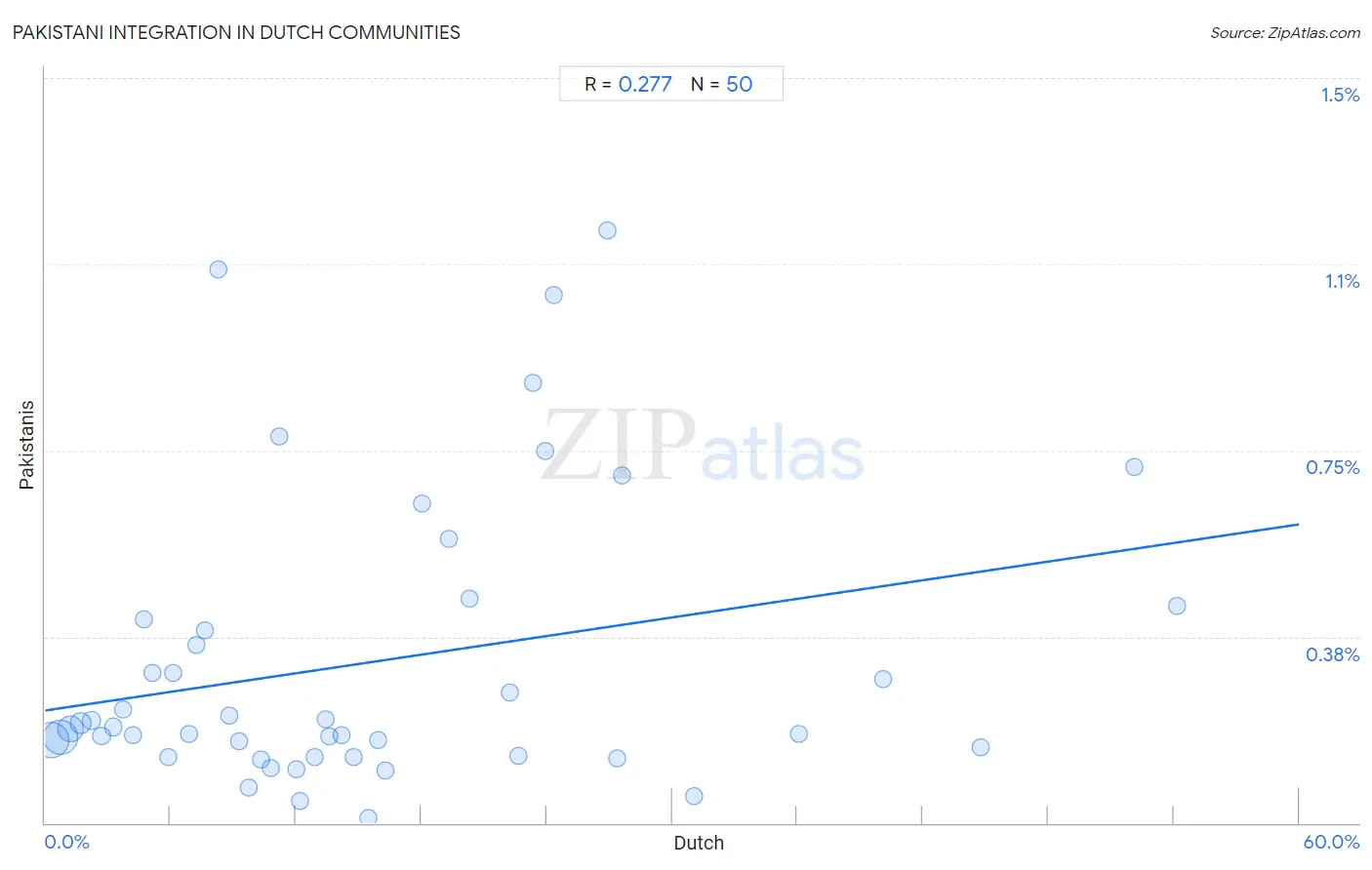
Dutch vs Pakistani Income
When considering income, the most significant differences between Dutch and Pakistani communities in the United States are seen in wage/income gap (29.6% compared to 26.1%, a difference of 13.7%), median female earnings ($37,339 compared to $40,596, a difference of 8.7%), and median household income ($82,971 compared to $89,638, a difference of 8.0%). Conversely, both communities are more comparable in terms of householder income under 25 years ($51,265 compared to $53,325, a difference of 4.0%), median male earnings ($54,410 compared to $56,719, a difference of 4.2%), and householder income ages 45 - 64 years ($99,650 compared to $105,317, a difference of 5.7%).

| Income Metric | Dutch | Pakistani |
| Per Capita Income | Fair $42,605 | Excellent $45,587 |
| Median Family Income | Fair $101,192 | Exceptional $107,390 |
| Median Household Income | Fair $82,971 | Exceptional $89,638 |
| Median Earnings | Poor $45,370 | Exceptional $48,254 |
| Median Male Earnings | Average $54,410 | Excellent $56,719 |
| Median Female Earnings | Tragic $37,339 | Excellent $40,596 |
| Householder Age | Under 25 years | Tragic $51,265 | Exceptional $53,325 |
| Householder Age | 25 - 44 years | Fair $93,081 | Excellent $98,401 |
| Householder Age | 45 - 64 years | Average $99,650 | Exceptional $105,317 |
| Householder Age | Over 65 years | Poor $59,539 | Exceptional $63,844 |
| Wage/Income Gap | Tragic 29.6% | Fair 26.1% |
Dutch vs Pakistani Poverty
When considering poverty, the most significant differences between Dutch and Pakistani communities in the United States are seen in single male poverty (14.1% compared to 12.4%, a difference of 13.7%), seniors poverty over the age of 65 (9.1% compared to 10.3%, a difference of 13.2%), and single father poverty (17.8% compared to 15.7%, a difference of 13.1%). Conversely, both communities are more comparable in terms of child poverty among boys under 16 (15.0% compared to 15.1%, a difference of 0.43%), child poverty among girls under 16 (15.1% compared to 15.3%, a difference of 0.99%), and child poverty under the age of 16 (14.8% compared to 15.0%, a difference of 1.9%).
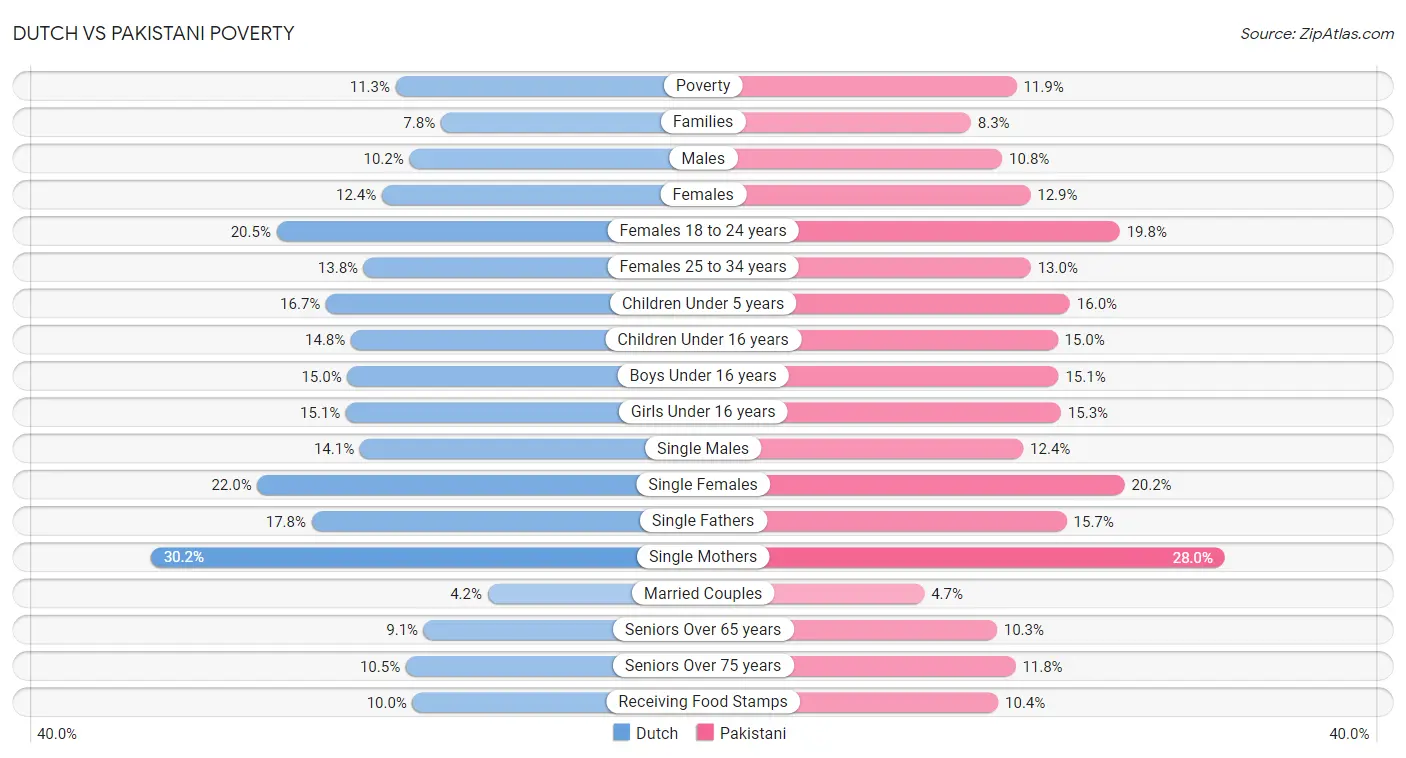
| Poverty Metric | Dutch | Pakistani |
| Poverty | Exceptional 11.3% | Excellent 11.9% |
| Families | Exceptional 7.8% | Exceptional 8.3% |
| Males | Exceptional 10.2% | Excellent 10.8% |
| Females | Exceptional 12.4% | Excellent 12.9% |
| Females 18 to 24 years | Poor 20.5% | Good 19.8% |
| Females 25 to 34 years | Fair 13.8% | Excellent 13.0% |
| Children Under 5 years | Good 16.7% | Exceptional 16.0% |
| Children Under 16 years | Exceptional 14.8% | Exceptional 15.0% |
| Boys Under 16 years | Exceptional 15.0% | Exceptional 15.1% |
| Girls Under 16 years | Exceptional 15.1% | Exceptional 15.3% |
| Single Males | Tragic 14.1% | Exceptional 12.4% |
| Single Females | Tragic 22.0% | Exceptional 20.2% |
| Single Fathers | Tragic 17.8% | Exceptional 15.7% |
| Single Mothers | Tragic 30.2% | Exceptional 28.0% |
| Married Couples | Exceptional 4.2% | Exceptional 4.7% |
| Seniors Over 65 years | Exceptional 9.1% | Exceptional 10.3% |
| Seniors Over 75 years | Exceptional 10.5% | Excellent 11.8% |
| Receiving Food Stamps | Exceptional 10.0% | Exceptional 10.4% |
Dutch vs Pakistani Unemployment
When considering unemployment, the most significant differences between Dutch and Pakistani communities in the United States are seen in unemployment among seniors over 75 years (10.4% compared to 8.9%, a difference of 17.6%), unemployment (4.6% compared to 5.1%, a difference of 11.9%), and female unemployment (4.6% compared to 5.1%, a difference of 11.7%). Conversely, both communities are more comparable in terms of unemployment among ages 25 to 29 years (6.5% compared to 6.5%, a difference of 0.60%), unemployment among seniors over 65 years (5.1% compared to 5.1%, a difference of 0.68%), and unemployment among ages 65 to 74 years (5.3% compared to 5.3%, a difference of 0.84%).
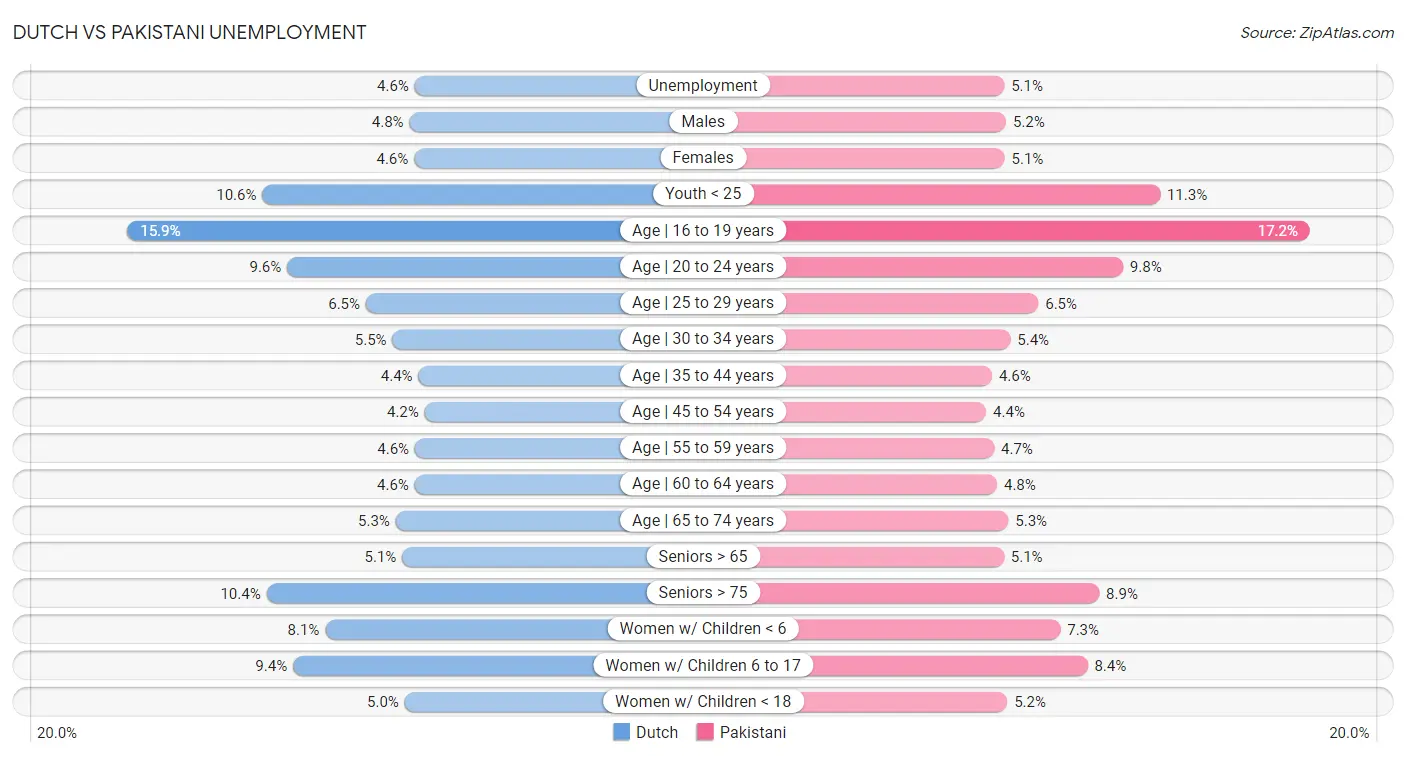
| Unemployment Metric | Dutch | Pakistani |
| Unemployment | Exceptional 4.6% | Excellent 5.1% |
| Males | Exceptional 4.8% | Excellent 5.2% |
| Females | Exceptional 4.6% | Excellent 5.1% |
| Youth < 25 | Exceptional 10.6% | Exceptional 11.3% |
| Age | 16 to 19 years | Exceptional 15.9% | Excellent 17.2% |
| Age | 20 to 24 years | Exceptional 9.6% | Exceptional 9.8% |
| Age | 25 to 29 years | Excellent 6.5% | Excellent 6.5% |
| Age | 30 to 34 years | Average 5.5% | Good 5.4% |
| Age | 35 to 44 years | Exceptional 4.4% | Good 4.6% |
| Age | 45 to 54 years | Exceptional 4.2% | Exceptional 4.4% |
| Age | 55 to 59 years | Exceptional 4.6% | Excellent 4.7% |
| Age | 60 to 64 years | Exceptional 4.6% | Good 4.8% |
| Age | 65 to 74 years | Good 5.3% | Excellent 5.3% |
| Seniors > 65 | Excellent 5.1% | Good 5.1% |
| Seniors > 75 | Tragic 10.4% | Fair 8.9% |
| Women w/ Children < 6 | Tragic 8.1% | Exceptional 7.3% |
| Women w/ Children 6 to 17 | Tragic 9.4% | Exceptional 8.4% |
| Women w/ Children < 18 | Exceptional 5.0% | Excellent 5.2% |
Dutch vs Pakistani Labor Participation
When considering labor participation, the most significant differences between Dutch and Pakistani communities in the United States are seen in in labor force | age 16-19 (43.8% compared to 37.6%, a difference of 16.8%), in labor force | age 20-24 (78.4% compared to 75.8%, a difference of 3.4%), and in labor force | age > 16 (64.2% compared to 65.8%, a difference of 2.5%). Conversely, both communities are more comparable in terms of in labor force | age 45-54 (82.8% compared to 82.8%, a difference of 0.080%), in labor force | age 35-44 (84.3% compared to 84.4%, a difference of 0.090%), and in labor force | age 25-29 (84.9% compared to 84.8%, a difference of 0.16%).

| Labor Participation Metric | Dutch | Pakistani |
| In Labor Force | Age > 16 | Tragic 64.2% | Exceptional 65.8% |
| In Labor Force | Age 20-64 | Fair 79.3% | Good 79.8% |
| In Labor Force | Age 16-19 | Exceptional 43.8% | Excellent 37.6% |
| In Labor Force | Age 20-24 | Exceptional 78.4% | Exceptional 75.8% |
| In Labor Force | Age 25-29 | Excellent 84.9% | Good 84.8% |
| In Labor Force | Age 30-34 | Fair 84.5% | Good 84.7% |
| In Labor Force | Age 35-44 | Fair 84.3% | Average 84.4% |
| In Labor Force | Age 45-54 | Good 82.8% | Average 82.8% |
Dutch vs Pakistani Family Structure
When considering family structure, the most significant differences between Dutch and Pakistani communities in the United States are seen in currently married (49.6% compared to 47.2%, a difference of 5.2%), single father households (2.4% compared to 2.3%, a difference of 5.0%), and single mother households (5.8% compared to 6.1%, a difference of 4.9%). Conversely, both communities are more comparable in terms of family households (64.9% compared to 64.7%, a difference of 0.44%), family households with children (27.4% compared to 27.9%, a difference of 2.0%), and births to unmarried women (31.5% compared to 30.5%, a difference of 3.4%).

| Family Structure Metric | Dutch | Pakistani |
| Family Households | Exceptional 64.9% | Excellent 64.7% |
| Family Households with Children | Fair 27.4% | Exceptional 27.9% |
| Married-couple Households | Exceptional 49.5% | Excellent 47.3% |
| Average Family Size | Tragic 3.11 | Fair 3.22 |
| Single Father Households | Poor 2.4% | Good 2.3% |
| Single Mother Households | Exceptional 5.8% | Good 6.1% |
| Currently Married | Exceptional 49.6% | Good 47.2% |
| Divorced or Separated | Tragic 12.4% | Excellent 11.9% |
| Births to Unmarried Women | Average 31.5% | Excellent 30.5% |
Dutch vs Pakistani Vehicle Availability
When considering vehicle availability, the most significant differences between Dutch and Pakistani communities in the United States are seen in no vehicles in household (6.8% compared to 9.0%, a difference of 31.2%), 4 or more vehicles in household (7.7% compared to 7.0%, a difference of 9.1%), and 3 or more vehicles in household (22.9% compared to 21.0%, a difference of 9.0%). Conversely, both communities are more comparable in terms of 1 or more vehicles in household (93.3% compared to 91.3%, a difference of 2.2%), 2 or more vehicles in household (61.6% compared to 57.9%, a difference of 6.5%), and 3 or more vehicles in household (22.9% compared to 21.0%, a difference of 9.0%).

| Vehicle Availability Metric | Dutch | Pakistani |
| No Vehicles Available | Exceptional 6.8% | Exceptional 9.0% |
| 1+ Vehicles Available | Exceptional 93.3% | Exceptional 91.3% |
| 2+ Vehicles Available | Exceptional 61.6% | Exceptional 57.9% |
| 3+ Vehicles Available | Exceptional 22.9% | Exceptional 21.0% |
| 4+ Vehicles Available | Exceptional 7.7% | Exceptional 7.0% |
Dutch vs Pakistani Education Level
When considering education level, the most significant differences between Dutch and Pakistani communities in the United States are seen in no schooling completed (1.4% compared to 2.1%, a difference of 47.8%), professional degree (4.0% compared to 4.8%, a difference of 18.3%), and doctorate degree (1.8% compared to 2.0%, a difference of 15.6%). Conversely, both communities are more comparable in terms of nursery school (98.7% compared to 97.9%, a difference of 0.74%), kindergarten (98.6% compared to 97.9%, a difference of 0.74%), and 1st grade (98.6% compared to 97.9%, a difference of 0.75%).
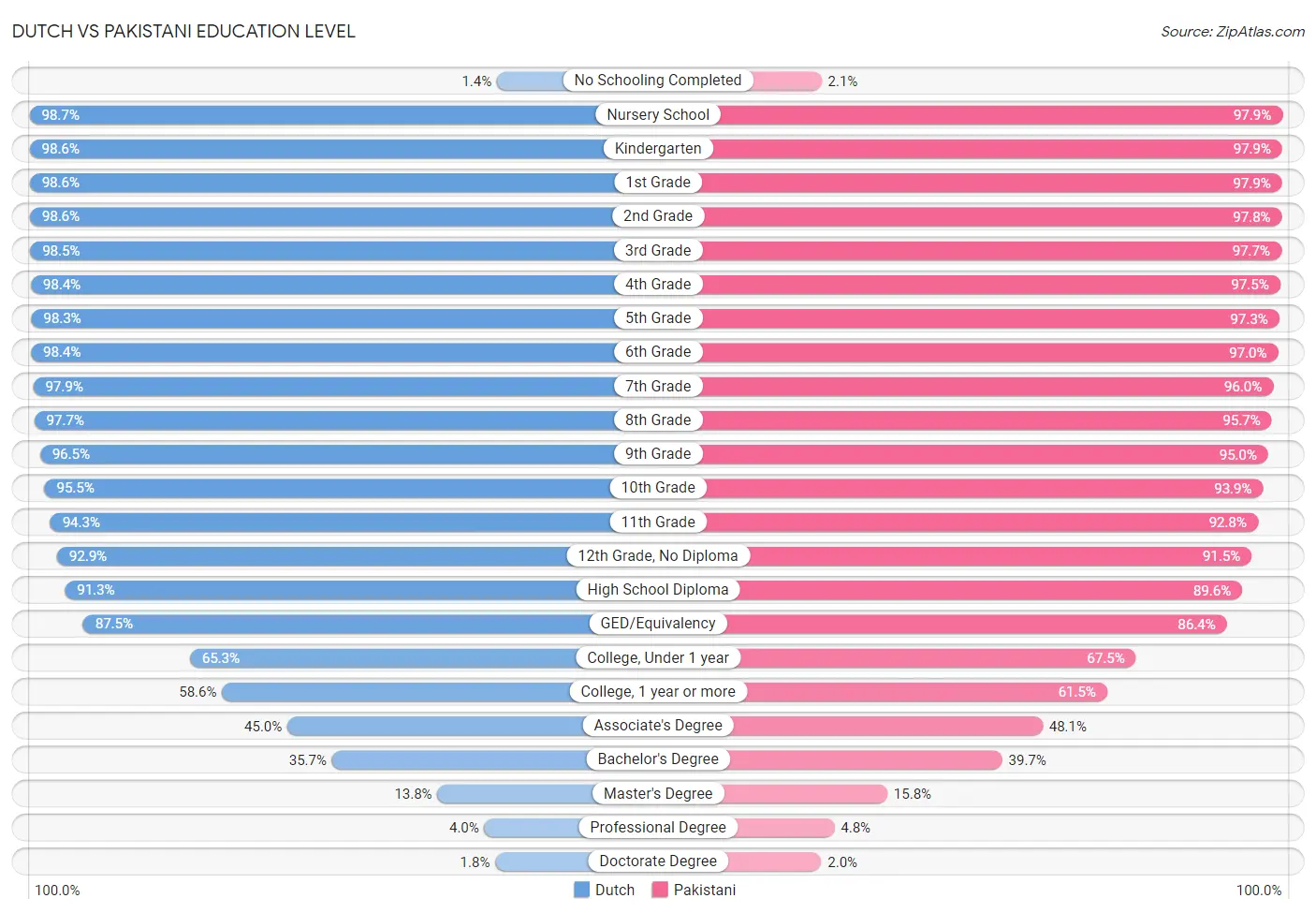
| Education Level Metric | Dutch | Pakistani |
| No Schooling Completed | Exceptional 1.4% | Average 2.1% |
| Nursery School | Exceptional 98.7% | Fair 97.9% |
| Kindergarten | Exceptional 98.6% | Fair 97.9% |
| 1st Grade | Exceptional 98.6% | Fair 97.9% |
| 2nd Grade | Exceptional 98.6% | Fair 97.8% |
| 3rd Grade | Exceptional 98.5% | Fair 97.7% |
| 4th Grade | Exceptional 98.4% | Fair 97.5% |
| 5th Grade | Exceptional 98.3% | Average 97.3% |
| 6th Grade | Exceptional 98.4% | Average 97.0% |
| 7th Grade | Exceptional 97.9% | Average 96.0% |
| 8th Grade | Exceptional 97.7% | Average 95.7% |
| 9th Grade | Exceptional 96.5% | Good 95.0% |
| 10th Grade | Exceptional 95.5% | Good 93.9% |
| 11th Grade | Exceptional 94.3% | Good 92.8% |
| 12th Grade, No Diploma | Exceptional 92.9% | Good 91.5% |
| High School Diploma | Exceptional 91.3% | Good 89.6% |
| GED/Equivalency | Exceptional 87.5% | Excellent 86.4% |
| College, Under 1 year | Average 65.3% | Exceptional 67.5% |
| College, 1 year or more | Fair 58.6% | Exceptional 61.5% |
| Associate's Degree | Poor 45.0% | Excellent 48.1% |
| Bachelor's Degree | Tragic 35.7% | Excellent 39.7% |
| Master's Degree | Tragic 13.8% | Excellent 15.8% |
| Professional Degree | Tragic 4.0% | Exceptional 4.8% |
| Doctorate Degree | Fair 1.8% | Exceptional 2.0% |
Dutch vs Pakistani Disability
When considering disability, the most significant differences between Dutch and Pakistani communities in the United States are seen in disability age under 5 (1.7% compared to 1.3%, a difference of 31.3%), hearing disability (3.7% compared to 3.1%, a difference of 19.1%), and disability age 18 to 34 (7.7% compared to 6.7%, a difference of 15.5%). Conversely, both communities are more comparable in terms of self-care disability (2.4% compared to 2.4%, a difference of 0.38%), disability age 65 to 74 (23.3% compared to 23.2%, a difference of 0.45%), and disability age over 75 (46.5% compared to 47.7%, a difference of 2.5%).
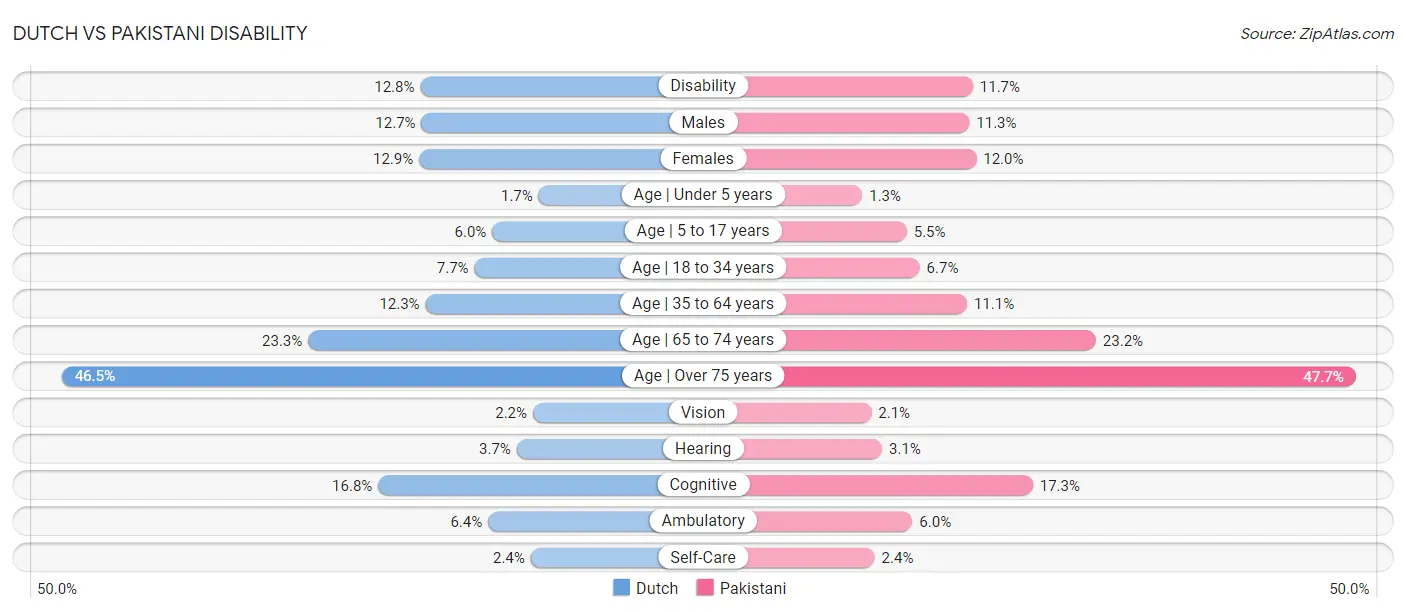
| Disability Metric | Dutch | Pakistani |
| Disability | Tragic 12.8% | Average 11.7% |
| Males | Tragic 12.7% | Fair 11.3% |
| Females | Tragic 12.9% | Excellent 12.0% |
| Age | Under 5 years | Tragic 1.7% | Poor 1.3% |
| Age | 5 to 17 years | Tragic 6.0% | Excellent 5.5% |
| Age | 18 to 34 years | Tragic 7.7% | Fair 6.7% |
| Age | 35 to 64 years | Tragic 12.3% | Good 11.1% |
| Age | 65 to 74 years | Average 23.3% | Average 23.2% |
| Age | Over 75 years | Exceptional 46.5% | Fair 47.7% |
| Vision | Poor 2.2% | Good 2.1% |
| Hearing | Tragic 3.7% | Poor 3.1% |
| Cognitive | Exceptional 16.8% | Average 17.3% |
| Ambulatory | Tragic 6.4% | Excellent 6.0% |
| Self-Care | Good 2.4% | Good 2.4% |